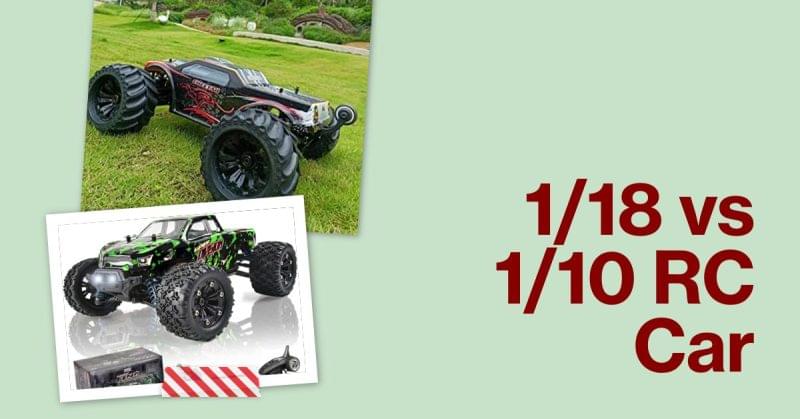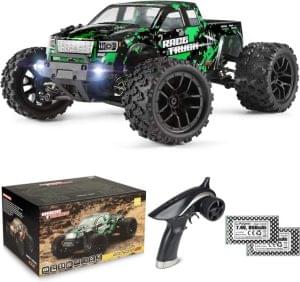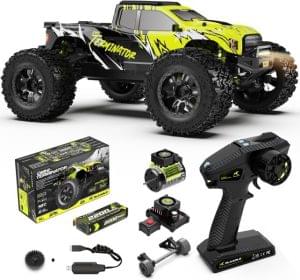RC cars are a popular hobby among enthusiasts of all ages, offering an exciting blend of speed, control, and customization. When it comes to selecting the right RC car, one of the key decisions is choosing the appropriate scale. The two most common scales in the RC car world are 1/18 and 1/10, and each has its unique advantages and considerations. In this comprehensive guide, we’ll delve into the differences between 1/18 and 1/10 RC cars, exploring factors such as size, performance, handling, and suitability for various environments.
Understanding RC Car Scales
Before we dive into the specifics of 1/18 and 1/10 RC cars, it’s essential to understand what these scales represent. The scale refers to the ratio of the RC car’s size compared to a real, full-sized vehicle. For example, a 1/18 scale RC car means that it is 1/18th the size of the actual vehicle it represents.
| Scale | Ratio |
|---|---|
| 1/18 | 1:18 |
| 1/10 | 1:10 |
As you can see, a 1/10 scale RC car is larger than a 1/18 scale RC car, which has implications for various aspects such as speed, handling, and suitability for different environments.
Size and Portability
One of the most apparent differences between 1/18 and 1/10 RC cars is their size. This factor plays a crucial role in determining portability, storage requirements, and the overall driving experience.
1/18 RC Cars
1/18 RC cars are compact and easy to transport, making them an excellent choice for those with limited space or who enjoy taking their RC cars on the go. These smaller cars can fit comfortably in backpacks or small carrying cases, allowing for convenient transportation and storage.
1/10 RC Cars
On the other hand, 1/10 RC cars are significantly larger and may require dedicated storage spaces or transportation arrangements. While their size can make them more challenging to move around, it also contributes to their commanding presence and overall driving experience.
Performance and Speed
The scale of an RC car has a direct impact on its performance capabilities, including top speed and acceleration. Generally, larger scales tend to offer higher top speeds and better acceleration, although other factors such as motor power and gearing also play a role.
1/18 RC Cars
1/18 RC cars are designed for indoor and small outdoor environments, typically offering top speeds ranging from 10 to 20 mph (16 to 32 km/h). While they may not reach the blistering speeds of larger scales, their compact size and maneuverability make them ideal for tight spaces and intricate driving environments.
1/10 RC Cars
1/10 RC cars, on the other hand, are built for high-speed performance and outdoor use. With their larger size and more powerful motors, these cars can achieve top speeds ranging from 30 to 60 mph (48 to 96 km/h), depending on the specific model and setup. This increased speed and power make 1/10 RC cars better suited for open spaces and more challenging terrain.
Handling and Control
The scale of an RC car also impacts its handling characteristics and the level of control required from the driver. Smaller scales tend to be more agile and responsive, while larger scales can offer more stability and traction, but may require more skill to control at higher speeds.
1/18 RC Cars
1/18 RC cars are known for their nimble handling and quick response times. Their smaller size and lower weight make them highly maneuverable, allowing for tight turns and precise driving in confined spaces. However, their lighter weight may also make them more susceptible to being affected by wind or uneven surfaces.
1/10 RC Cars
1/10 RC cars, with their larger size and weight, offer a more stable driving experience, especially at higher speeds. Their increased traction and momentum can make them more forgiving on rough terrain, but they may require more input from the driver to execute sharp turns or sudden maneuvers. Additionally, their increased weight can make them more challenging to control in tight spaces or indoor environments.
Terrain Suitability
The scale of an RC car plays a significant role in determining the types of terrain and environments it can handle effectively. While both 1/18 and 1/10 RC cars can be used on various surfaces, their respective strengths and limitations should be considered.
1/18 RC Cars
1/18 RC cars are well-suited for indoor environments, such as living rooms, garages, or small outdoor spaces like patios or driveways. Their compact size and maneuverability make them ideal for navigating tight spaces and avoiding obstacles. However, their smaller wheels and lighter weight may make them less capable on rougher outdoor terrain or in challenging conditions like mud or deep grass.
1/10 RC Cars
1/10 RC cars, with their larger size and more robust construction, are better equipped to handle outdoor environments and challenging terrain. Their bigger wheels and increased ground clearance allow them to navigate over obstacles, rough surfaces, and various off-road conditions with relative ease. However, their larger size may make them less suitable for indoor use or confined spaces where maneuverability is crucial.
Customization and Upgrades
Both 1/18 and 1/10 RC cars offer a wealth of customization and upgrade options, catering to enthusiasts who enjoy personalizing their vehicles and enhancing performance.
1/18 RC Cars
While 1/18 RC cars may have fewer aftermarket parts and accessories available compared to their larger counterparts, there are still numerous options for upgrading components such as motors, batteries, tires, and body shells. These upgrades can improve speed, handling, and overall performance, allowing hobbyists to tailor their 1/18 RC cars to their preferences.
1/10 RC Cars
1/10 RC cars have a vast ecosystem of aftermarket parts, upgrades, and accessories available from various manufacturers. From high-performance motors and speed controllers to suspension upgrades and custom body shells, the customization possibilities for 1/10 RC cars are nearly endless. This level of customization appeals to enthusiasts who enjoy modifying and fine-tuning their vehicles for optimal performance and personal style.
Cost Considerations
The cost of an RC car is another crucial factor to consider when choosing between 1/18 and 1/10 scales. While prices can vary widely depending on the brand, features, and quality, there are general trends to keep in mind.
1/18 RC Cars
1/18 RC cars typically have a lower entry cost compared to their 1/10 counterparts. Entry-level 1/18 RC cars can be found for as little as $50 to $100, making them an affordable option for beginners or those on a budget. However, as with any hobby, higher-end models and upgrades can increase the overall cost.
1/10 RC Cars
1/10 RC cars tend to be more expensive than their 1/18 counterparts, with entry-level models starting at around $150 to $300. The increased cost is primarily due to their larger size, more powerful components, and advanced features. High-end 1/10 RC cars, especially those designed for racing or off-road use, can easily exceed $500 or even $1,000 when including upgrades and customizations.
Choosing the Right Scale
With a clear understanding of the differences between 1/18 and 1/10 RC cars, it’s important to consider your specific needs and preferences when making a choice. Here are some factors to consider:
1/18 RC Cars are Ideal for:
- Indoor or small outdoor environments
- Portability and easy storage
- Beginners or those with limited space
- Tight spaces and intricate driving environments
1/10 RC Cars are Ideal for:
- Outdoor and off-road environments
- High-speed performance and racing
- Hobbyists seeking customization and upgrades
- Larger driving spaces and challenging terrain
Ultimately, the decision between a 1/18 or 1/10 RC car will depend on your specific preferences, available space, budget, and the type of driving experience you’re seeking.
Conclusion
When it comes to choosing between a 1/18 or 1/10 RC car, there is no one-size-fits-all answer. Both scales offer unique advantages and cater to different driving styles and environments. Whether you prioritize portability, speed, handling, or off-road capabilities, understanding the differences between these two scales will help you make an informed decision that aligns with your preferences and goals.
Remember, the joy of RC cars lies in the thrill of driving and the satisfaction of customization. Whichever scale you choose, embrace the hobby with enthusiasm, and don’t be afraid to explore different options as your skills and interests evolve. Happy driving!


